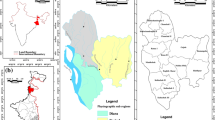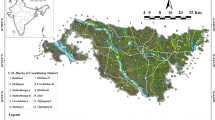Abstract
Paschim medinipur is one of the backward as well as highly flood prone district in the state of West Bengal, India. For many reason, the most frequent choice should be protection from the flooding by means of physical control of river. Though it is not possible to control the flood disaster totally. To minimize the flood damages analysis of flood vulnerability and risk assessment is an important strategy. For this work some physical and social variables has been selected who’s potential to be harmed during the time of floods. While hazards are a potential threat to population and environment, risk is interplay between hazard and vulnerability. To evaluate the vulnerability analysis and risk assessment of flood, analytic hierarchy process and weighted linear combination has been used to functionalize the conceptual model within a GIS framework. To delineate the flood risk zones a composite vulnerability index map has been prepared which is accomplish with Physical Vulnerability Index, Social Vulnerability Index and Coping Capacity Index. Analysis revealed that 24.25% of the population lives in high to very high flood risk zones. Almost 17.76% of mud houses which are severe damage by floods located in high to very high risk zones.















Similar content being viewed by others
References
Apel H, Aronica GT (2009) Flood risks analysis – how detailed do we need to be? Nat Hazard 49(1):79–98
Cutter SL, Emrich CT (2009) Social vulnerability to climatic variability hazards: a review of literature. Final report to Oxfam America. http://adpt.oxfamamerica.org/resources/Literature_Review.pdf. Accessed 2010
Cutter SL, Boruff BJ, Shirley WL (2003) Social vulnerability to environmental hazards*. Soc Sci Quart 84:242–261. doi:10.1111/1540-6237.8402002
D’Oyley V, Blunt A (1994) Education and development: lessons from the third world. Detseling enterprises, Calgary
Dasgupta A (2007) Floods and poverty traps: evidence from Bangladesh. Econ Pol Wkly 42(30):3166–3171
Few R (2003) Flooding, Vulnerability and coping strategies: local responses to a global threat. Prog Dev 3(1):43–58
Liverman DM (1990) Drought in Mexico: climate, agriculture, technology and land tenure in Sonora and Puebla. Ann Assoc Am Geogr 80(1):49–72
Paul BK (1997) Flood research in Bangladesh in retrospect and prospect: a review. Geoforum 28:121–131
Paul SK, Routray JK (2010) Flood proneness and coping strategies: the experiences of two villages in Bangladesh. Disasters 34(2):489–508
Ramanathan R (2001) A note on the use of the analytic hierarchy process for environmental impact assessment. doi:10.1006/jema.2001.0455
Saaty TL (1980) The analytic hierarchy process. McGraw-Hill, New York, pp 20–25
Yoshino F, Yoshikawa K (1985) A study on flood risk mapping. In: Proceedings of the international symposium on erosion, debris flow and disaster prevention, Tsukuba, Japan, pp 499–504
Author information
Authors and Affiliations
Corresponding author
Rights and permissions
About this article
Cite this article
Dandapat, K., Panda, G.K. Flood vulnerability analysis and risk assessment using analytical hierarchy process. Model. Earth Syst. Environ. 3, 1627–1646 (2017). https://doi.org/10.1007/s40808-017-0388-7
Received:
Accepted:
Published:
Issue Date:
DOI: https://doi.org/10.1007/s40808-017-0388-7




